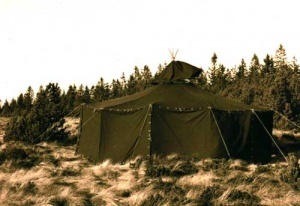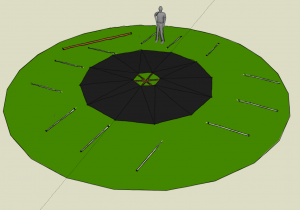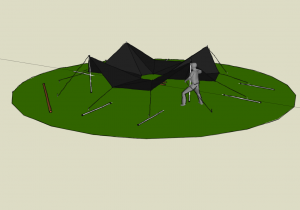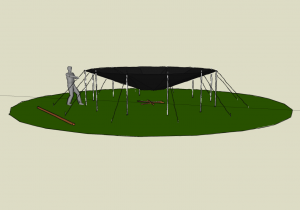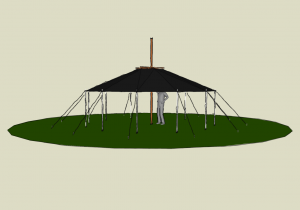Wie baue ich eine Jurte auf?/en: Unterschied zwischen den Versionen
Ralph (Diskussion | Beiträge) (Die Seite wurde neu angelegt: „When you have a roof with eaves you just button the tarps from the inside to the button tab of the roof tarp. To connect the tarps to each other you have to co…“) |
Ralph (Diskussion | Beiträge) (Die Seite wurde neu angelegt: „Having a roof tarp without eaves these eyelets need to be hooked to the tips of the side poles. For this you have to remove each pole hook the tarp in and brin…“) |
||
| Zeile 49: | Zeile 49: | ||
When you have a roof with eaves you just button the tarps from the inside to the button tab of the roof tarp. To connect the tarps to each other you have to connect each of both buttons into the opposite buttonhole. With the newer roof tarps the corner-eyelets of the tarps are secured with rubber bands. | When you have a roof with eaves you just button the tarps from the inside to the button tab of the roof tarp. To connect the tarps to each other you have to connect each of both buttons into the opposite buttonhole. With the newer roof tarps the corner-eyelets of the tarps are secured with rubber bands. | ||
Having a roof tarp without eaves these eyelets need to be hooked to the tips of the side poles. For this you have to remove each pole hook the tarp in and bring it back. | |||
Selbstverständlich kannst du die Seitenplanen bereits ganz zu Beginn ans Dach knüpfen. Vor allem für kleine Menschen und hohe Seitenwände ist dies zu empfehlen, da es sonst mit der Zeit lahme Arme gibt, wenn du alle Seiten weit über Kopf anbringen willst. | Selbstverständlich kannst du die Seitenplanen bereits ganz zu Beginn ans Dach knüpfen. Vor allem für kleine Menschen und hohe Seitenwände ist dies zu empfehlen, da es sonst mit der Zeit lahme Arme gibt, wenn du alle Seiten weit über Kopf anbringen willst. | ||
Version vom 11. April 2017, 13:42 Uhr
This manual describes the setting of a yurt. For pitching we use a single centre pole. Even though this manual basically describes the steps to pitch a TORTUGA yurt the steps to pitch TROLL or RAINBOW are roughly the same. In particular we here describe the setting of a standard yurt with a diameter of 6m and a sidewall height of 1,65m. Higher yurts or the supersize yurt can be set up, too, following this manual analogously.
Was benötigst du, um eine Jurte aufzustellen?
Es gibt sicher viele Wege eine Jurte aufzustellen und entsprechend unterscheidet sich auch das verwendete Material. Die folgenden Stücklisten geben einen Überblick, was du benötigst, um auch als Einsteiger einfach und sicher eine Jurte aufstellen zu können. Nicht genannt ist das Werkzeug, wie Hammer (für die Heringe) oder Säge (für die Jurtenstangen) oder ein Messer (um evtl. Seile anzupassen).
Jurte
- 1 Jurtendach, 600 cm, mit oder ohne Traufkante
- 6 Doppelzeltbahnen 323 x 165 cm (oder 12 Viereckzeltbahnen)
- 1 Jurten-Abdeckplane mit Rundleine
- 1 Jurtenkreuz oder Jurtenspinne, 6-fach
- 2 Mittelstangen ca. 420 cm
- 12 Aufstellstäbe min 165 cm
- 12 Heringe
- 12 Abspannseile, min 300 cm
- 12 Erdnägel
- 1 Blockseilrolle
- 1 Kunsthanfseil, ca. 300 cm
- 1 Kunsthanfseil, ca. 600 cm
- etwas Bindeschnur
Super-Jurte
- 1 Jurtendach, 600 cm, mit oder ohne Traufkante
- 6 Super-Doppelzeltbahnen 323 x 209 cm (oder 12 Super-Viereckplanen)
- 1 Jurten-Abdeckplane mit Rundleine
- 1 Jurtenkreuz oder Jurtenspinne, 6-fach
- 2 Mittelstangen ca. 510 cm
- 12 Aufstellstäbe min 209 cm
- 12 Heringe
- 12 Abspannseile, min 450 cm
- 12 Erdnägel
- 1 Blockseilrolle
- 1 Kunsthanfseil, ca. 300 cm
- 1 Kunsthanfseil, ca. 900 cm
- etwas Bindeschnur
Großjurte
- 1 Großjurtendach, 800 cm, mit Traufkante
- 8 Doppelzeltbahnen 323 x 165 cm (oder 16 Viereckzeltbahnen)
- 1 Jurten-Abdeckplane mit Rundleine
- 1 Jurtenkreuz oder Jurtenspinne, 8-fach
- 2 Mittelstangen ca. 510 cm
- 16 Aufstellstäbe min 165 cm
- 16 Heringe
- 16 Abspannseile, min 300 cm
- 16 Erdnägel
- 1 Blockseilrolle
- 1 Kunsthanfseil, ca. 300 cm
- 1 Kunsthanfseil, ca. 900 cm
- etwas Bindeschnur
Super-Großjurte
- 1 Großjurtendach, 800 cm, mit Traufkante
- 8 Super-Doppelzeltbahnen 323 x 209 cm (oder 16 Super-Viereckplanen)
- 1 Jurten-Abdeckplane mit Rundleine
- 1 Jurtenkreuz oder Jurtenspinne, 8-fach
- 2 Mittelstangen ca. 510 cm
- 16 Aufstellstäbe min 209 cm
- 16 Heringe
- 16 Abspannseile, min 450 cm
- 16 Erdnägel
- 1 Blockseilrolle
- 1 Kunsthanfseil, ca. 300 cm
- 1 Kunsthanfseil, ca. 900 cm
- etwas Bindeschnur
Giga-Großjurte
- 1 Giga-Jurtendach, 920 cm, mit Traufkante
- 9 Super-Doppelzeltbahnen 323 x 209 cm (oder 18 Super-Viereckplanen)
- 1 Jurten-Abdeckplane mit Rundleine
- 1 Jurtenkreuz oder Jurtenspinne, 9-fach
- 2 Mittelstangen ca. 510 cm
- 18 Aufstellstäbe min 209 cm
- 18 Heringe
- 18 Abspannseile, min 450 cm
- 18 Erdnägel
- 1 Blockseilrolle
- 1 Kunsthanfseil, ca. 300 cm
- 1 Kunsthanfseil, ca. 900 cm
- etwas Bindeschnur
How to pitching a yurt?
Lay out the roof
Lay the roof tarp outside up, exactly where you want have the yurt pitched (Half tarps or kota panels need to be lashed beforehand). The more accurate you lay out, the more stabile the yurt will stand later. The tarp should now show a regular dodecagon (hexadecagon for the supersize yurt).
When you look at the roof tarp you see a seam running from every corner towards the smoke hole. The imaginary extension of this seam shows you where the stakes and the 550 cord will have to placed later.
Lay out the side poles
The length of the poles has of course to follow the height of the sidewall. To gain more flexibility the use of adjustable telescope poles (basher pole) is recommended. The usual height, using the double square tarps, is 1,65m. In conjunction with the window panels or the super square- or super double square-tarp you can reach a height up to approx. 2,05m.
Take the poles and place them tip to D-ring (roof with eaves) respectively eyelet (roof without eaves). Place the poles on the before mentioned imaginary extension of the seam line pointing towards the centre of the fire hole. The bottom end of the pole marks the spot where you place the tent pegs. For staking out in hard soil T-profile stakes are recommended in soft soil you can even use wooden stakes. The pegs should be driven into the ground at least two third of their length.
Attach the guy ropes
The usable length of the cord should be approximately one and a half times of the side pole length. Attach one end to the D-Ring (or eyelet) of the roof tarp and the other end to the tent peg. If you tighten and loose the line from stake side or from D-Ring side (where you set the taut line hitch) is up to your choice.
Set up the side poles
Next you can start setting up the side poles to bring the side of the roof tarp to the required height. Up to this point all steps could easily be done by one single person. With a bit of experience it’s still possible to carry on alone but it would be easier with some helping hands that help you keeping the poles up.
Start with any pole by putting the tip into the D-Ring and bringing it into a vertical position. If there is a second person helping, your partner should start simultaneously on the opposite pole.
The next two poles should be ones halfway between the already set up ones and so on. Carry on this way until all 12 (16) poles are set up. Once finished the roof is now hanging in the air with the middle section pointing to the ground looking like a funnel.
At this stage the whole construction is still shaky and wind prone (that’s why additional helping hands to stabilise the poles are recommended). As soon as all cords get tightened equably the construction will stand all alone.
Hanging in the chain
Clip the 6 (8) single beams of the yurt chain into the D-Rings of the smoke hole. With D-shackles you can clip into D-ring as well as into eyelets. If your roof tarp is lashed out of single Kota-tarp be sure to always connect two eyelets with one D-shackle.
Instead of using the chain you can also use a yurt cross with bolts. Just hang the D-rings into the bolts. Tie the long rope to the carabiner in the centre of the yurt chain. This will later serve for pulling up the roof.
Set up centre pole
First tie the pulley with the short rope close to top end of the pole. Thread the long rope through the pulley. Now bring top end of the pole from underneath the tarp through the smoke hole and get the pole into a vertical position (some helping hands are definitely recommended). Pulling the roof up a bit in between this process makes it easier getting the pole into a vertical position.
Once the pole stands even pull the roof to the top and tie the rope to the pole. If this doesn’t work properly or the tarp shows pleats or is even sagging you’d have to check the anchor points (tent pegs) and maybe readjust them to ensure that they’re really in one line with the seam line. Slightly loosening or tightening the ropes may also help.
Mounting the sidewall tarps
When you have a roof with eaves you just button the tarps from the inside to the button tab of the roof tarp. To connect the tarps to each other you have to connect each of both buttons into the opposite buttonhole. With the newer roof tarps the corner-eyelets of the tarps are secured with rubber bands.
Having a roof tarp without eaves these eyelets need to be hooked to the tips of the side poles. For this you have to remove each pole hook the tarp in and bring it back.
Selbstverständlich kannst du die Seitenplanen bereits ganz zu Beginn ans Dach knüpfen. Vor allem für kleine Menschen und hohe Seitenwände ist dies zu empfehlen, da es sonst mit der Zeit lahme Arme gibt, wenn du alle Seiten weit über Kopf anbringen willst. Wenn du die Seitenplanen alle senkrecht miteinander verbunden hast, ist deine Jurte so gut wie fertig. Du kannst die Aufstellstäbe noch einmal richtig ausrichten und damit auch die Seiten der Jurte straffen. Zudem kannst du die Seitenplanen am unteren Ende ebenfalls mit Heringen sichern. Das ist bei windigem Wetter sehr vorteilhaft.
Wie kommst du in die Jurte?
Entweder lässt du einfach ein ganzes Feld frei, durch welches du in die Jurte hinein kannst, oder du lässt eine senkrechte Verbindung offen und kannst die Seitenplanen dort jeweils wie ein Dreieck zur Seite schlagen. Mit einem kurzen Stück Bindeschnur kannst du die Seitenbahn an der gewünschten Stelle festbinden bzw. einhängen.
Brauchst du eine Jurtenabdeckplane?
Die Jurte ist ein Feuerzelt. Und am besten zieht der Rauch ab, wenn das Rauchloch weit geöffnet ist. Nur kommt dadurch auch gerne der Regen ins Innere der Jurte. Wenn dich dies nicht sonderlich stört bist du nun fertig. Willst du dich vor dem Regen schützen, solltest du die Abdeckplane anbringen.
Wie wird die Jurtenabdeckplane befestigt?
Deine Abdeckplane besteht aus sieben Feldern und hat acht Ösen, um daran dünne Schnüre anzubringen. Wir verwenden in aller Regel Sisal (billige Bindeschnur), das kannst du auf die gewünschte Länge zuschneiden und auch für viele andere Zwecke verwenden. Bei einer Jurte mit sechs Meter Durchmesser sollten die Schnüre etwa vier bis fünf Meter lang sein.
Nun kannst du die Abdeckplane nach oben aufs Dach ziehen, in der Mitte hoch steigen, dich durchs Rauchloch zwängen und die Spitze der Abdeckplane um den Kreuzungspunkt der beiden Mittelstangen binden. Das ist recht umständlich, wir machen uns das Ganze etwas einfacher und nicht in schwindelnder Höhe.
Wichtig ist die Entscheidung, wie hoch die Abdeckplane später über dem Rauchloch hängen wird. Soll sie dicht schließen und der Stoff möglichst auf dem Jurtendach aufliegen? Oder soll ein mehr oder minder großer Spalt für den Rauchabzug bleiben? Das legst du bereits mit dem Bindepunkt der Mittelstangen fest. Denn idealerweise wird an dieser Stelle auch die Jurtenabdeckplane um die Stangen gebunden.
Und das geht eben am besten, wenn das Dach herabgelassen ist, dann hast du bequem die Füße auf dem Boden, kannst dir das Rauchloch um die Schultern hängen und alles entsprechend vorbereiten. Die Schnüre sollten nicht verheddert sein, sonst kommst du nachher von außen schwerer dran, wenn du das Dächlein über dem Rauchloch abspannen willst.
Zuletzt nimmst du deine acht Schnüre und legst die mit einem Spannknoten an die entsprechenden Abspannschnüre an. Welche die richtige ist, das musst du einfach ausprobieren. In der Theorie ist es jede zweite Abspannschnur, das hängt nun aber auch ein wenig von der Anbringung ab, wie der Stoff fällt und wie sich die Abdeckplane ziehen lässt. Zum Schluss sollte auf jeden Fall ein Segment der Jurtenabdeckplane überlappend abgespannt sein.
Du kannst die Abdeckplane eben auch so anbringen, dass deren Stoff auf dem Jurtendach aufliegt und so bestmöglich gegen den Regen schützt. Mittels der Schnüre kannst du die Jurtenabdeckplane jederzeit wieder zur Seite ziehen, z.B. die Hälfte (oder mehr oder weniger) aufziehen, den Rauch raus lassen und später wieder schließen.
Wie bei allem im Jurtenbau macht die Übung den Meister und die Freude am Experimentieren zeigt dir den für dich richtigen Weg.
Ein Video über den Aufbau der Jurte
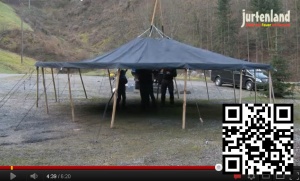
Unser Video auf Youtube zeigt dir die grundlegenden Schritte. So siehst du sehr deutlich, wie eins ins andere greift und wie du am besten an den Aufbau deiner Jurte herangehst.
